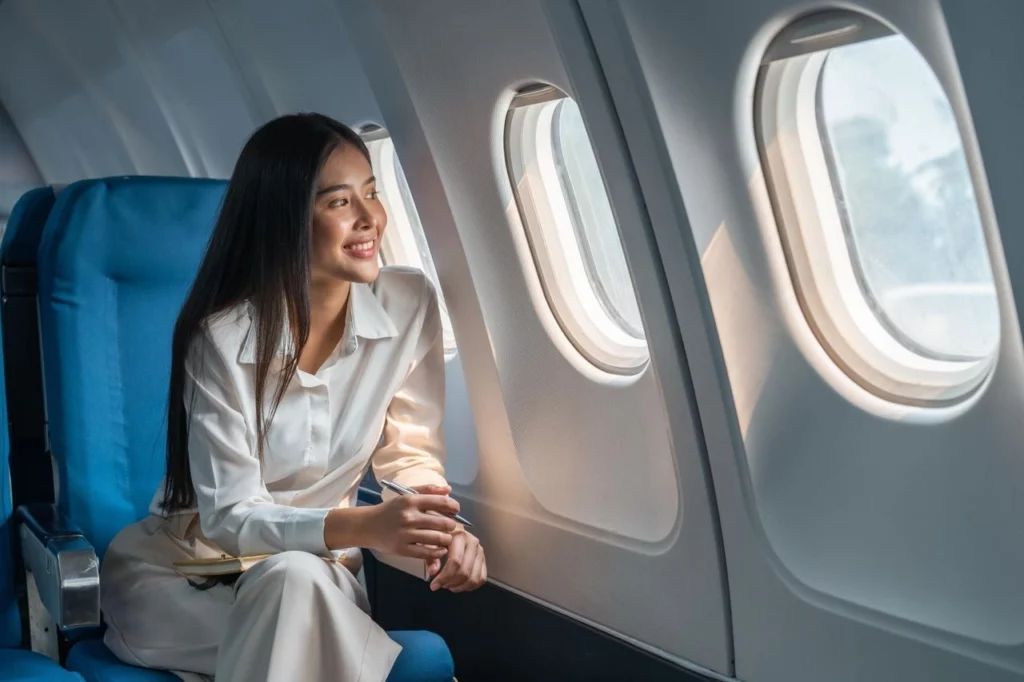When Is It Safe to Fly After Nose Surgery?
Why You Need to Wait Before Flying?
Air Pressure Effects
Flying after rhinoplasty presents unique challenges due to aircraft cabin pressure changes. These shifts can significantly impact the healing nose, causing the tissues to expand and potentially disrupting the delicate post-surgical site. Patients may experience increased sinus pressure, which is particularly problematic since the nasal passages are highly sensitive. The strain on the healing structures might cause discomfort and trigger complications, such as nose bleeds or excessive swelling. Additionally, cabin pressure fluctuations and normal post-surgical inflammation can create a painful experience, particularly during takeoff and landing when pressure changes are most dramatic. For this reason, Dr. Zarrabi recommends allowing the nose to heal sufficiently before exposing it to these challenging conditions.
Swelling Risks
Blood Clot Concerns
One of the most significant medical concerns about flying too soon after rhinoplasty is the increased risk of developing blood clots, such as deep vein thrombosis (DVT). During air travel, prolonged immobility combined with the pressure changes in the cabin can affect circulation, especially during longer flights. While rhinoplasty carries a relatively low risk of clotting compared to other surgical procedures, the airplane environment creates additional hazards. The body’s natural healing response after surgery already increases clotting tendencies, and when coupled with flight conditions, patients may face a higher likelihood of complications. This is why Dr. Zarrabi recommends waiting until the initial healing phase is complete before undertaking any air travel, especially if it lasts more than a few hours.
Disrupted Healing Process After Nasal Surgery
Factors That May Affect Your Flying Timeline
Type of Rhinoplasty Surgery Performed
The complexity and extent of your nasal surgery play a crucial role in determining when you can safely resume air travel. A skilled rhinoplasty surgeon will consider whether you underwent an open or closed procedure and the techniques used during the operation. For instance, patients with extensive cartilage grafting or septoplasty typically require longer waiting periods before flying than those who underwent minor tip refinements. Complex procedures involve more comprehensive tissue manipulation and longer healing times, which could be compromised by early air travel. The structural integrity of the newly shaped nose needs adequate time to stabilize. Dr. Zarrabi carefully evaluates each case to provide personalized travel recommendations based on the specific surgical techniques employed.
Individual Healing Rate
Length of Flight
The duration of the planned flight significantly influences when the patient can safely travel after rhinoplasty. Short domestic routes (under 2-3 hours) generally pose fewer risks than long-haul international journeys, as extended exposure to pressure changes and cabin conditions may increase the likelihood of complications. Dr. Zarrabi usually approves shorter flights sooner than longer ones, recommending an additional week or two of recovery time for travel exceeding 4-6 hours. This conservative approach helps ensure your nose has adequate time to heal before enduring prolonged air transportation stress.
Overall Health Condition
Pre-Flight Preparation
Before boarding your flight, take several preventive measures to ensure a comfortable journey. Schedule a final check-up with your surgeon to confirm you’re cleared for travel and obtain any necessary documentation about your procedure for airport security. Pack essential items like saline nasal spray to combat cabin dryness, arnica gel for swelling management, and any prescribed medications. Choose an aisle seat to facilitate easy movement, and consider booking flights during off-peak hours to minimize stress and crowding.
During Flight Care
While in the air, focus on maintaining your comfort and protecting your healing nose. Use saline spray every few hours to keep your nasal passages moist and stay well-hydrated throughout the flight. Avoid bending or looking down for extended periods, and take regular walks along the aisle to promote circulation. If you experience any discomfort during altitude changes, try gentle breathing exercises through your mouth rather than your nose. Avoid touching or bumping the treated area, particularly when retrieving items from overhead compartments.
Precautions to Take
Exercise extra caution when handling your luggage and navigating crowded spaces in the airport and aircraft. Dr. Zarrabi recommends wearing a protective face mask to shield your nose from accidental bumps and reduce exposure to airborne particles. Consider bringing a small ice pack or cold compress to manage any unexpected swelling, and keep your prescribed pain medication easily accessible. If possible, arrange for assistance with heavy bags and request pre-boarding to avoid the rush of other passengers. Most importantly, listen to your body and don’t hesitate to alert flight staff if you experience any unusual discomfort during the journey.
Tips for Flying After Rhinoplasty
Dr. Zarrabi employs the advanced piezo ultrasonic rhinoplasty technique, representing a significant advancement in nasal surgery. Unlike traditional methods that rely on manual tools, this innovative approach uses ultrasound energy to precisely reshape bones, resulting in less trauma to surrounding tissues. The gentler technique typically reduces swelling, bruising, and postoperative discomfort, potentially allowing patients to resume normal activities, including air travel, sooner than conventional rhinoplasty approaches. While Dr. Zarrabi still recommends following standard recovery guidelines, many people experience a smoother healing process thanks to this state-of-the-art technology.





